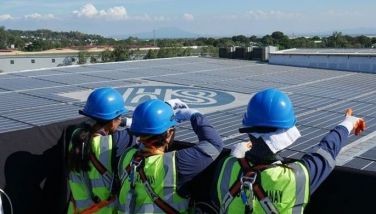Philippines, China hold talks after Escoda Shoal collisions

MANILA, Philippines — After a month of trading accusations over incidents near Escoda (Sabina) Shoal, the Philippines and China on Wednesday, September 12, vowed to continue engaging diplomatic channels even as they assert their territorial claims.
The meeting in Beijing between Foreign Affairs Undersecretary Theresa Lazo and her Chinese counterpart, Chinese Vice Foreign Minister Chen Xiaodong, follows an earlier round of talks held in July when both parties agreed to a “provisional arrangement” on the Philippines’ resupply missions to BRP Sierra Madre in Ayungin Shoal.
Lazaro reaffirmed the Philippines’ position on Escoda Shoal, located deep within the country’s 200-nautical mile exclusive economic zone. Both parties also “explored ways to lower tensions in the area,” the Department of Foreign Affairs said in a statement Thursday, September 12.
Both countries also agreed to continue discussions on hotline mechanisms, coast guard cooperation and marine scientific and technological cooperation.
They also reaffirmed the use of the bilateral consultation mechanism — the official term for meetings between the two countries’ foreign affairs officials — as “a forum for promoting maritime dialogue and enhancing bilateral cooperation while agreeing to continue engagement through diplomatic channels.“
The Chinese foreign ministry described this latest round of talks as a “frank and in-depth exchange of views on maritime issues” with a focus on Escoda Shoal, claimed by China as Xianbian Jao.
The Chinese vice foreign minister reiterated Beijing’s position and again called on the Philippines “to immediately withdraw relevant vessels from Xianbin Jiao,” according to the Chinese foreign ministry’s statement.
Philippine Coast Guard (PCG ) vessel BRP Teresa Magbanua has been stationed in Escoda Shoal since April amid reports of China's reclamation activities in the area.
Beijing has repeatedly urged the Philippines to tow the vessel as its presence supposedly violates China’s territorial sovereignty.
In August, at least three collisions between Philippine and Chinese vessels took place near or within the waters of Escoda Shoal, a feature located some 75 nautical miles from Palawan.
The latest altercation on August 31 saw one Chinese coast guard deliberately ramming BRP Teresa Magbanua thrice, according to PCG Spokesperson Jay Tarriela, who also shared video footage of the incident. This left a man-sized hole on BRP Teresa Magbanua, while no crew was injured.
The Philippines condemned the Chinese Coast Guard for its “unprovoked aggression” amid Philippine vessels’ “peaceful and lawful patrol within its own maritime jurisdiction.”
The flareup of tensions near Escoda Shoal, regarded as the new flashpoint of maritime tensions between the Philippines and China, follows the signing of a deal between the two countries in July aimed at de-escalating tensions in the West Philippine Sea.
Maritime experts believe this deal is limited only to maritime interactions near Ayungin Shoal and could be the impetus for China to step up its presence in other parts of the contested waters.
China considers almost the entire South China Sea, including waters referred to by the Philippines as the West Philippine Sea, to be its territorial waters.
On July 12, 2016, a tribunal constituted under the United Nations Conventional of the Law of the Sea dismissed China’s expansive nine-dash line claim in the South China Sea.
- Latest
- Trending






























